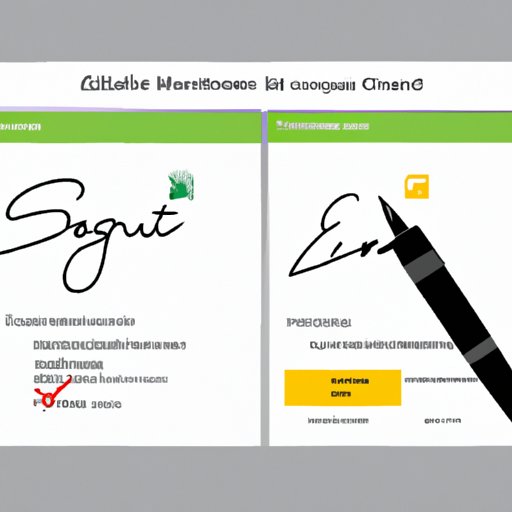I. Introduction
Your email signature is an important aspect of your professional image. It provides valuable contact information for your clients, colleagues, and potential business partners. A well-crafted email signature can leave a lasting impression and help you stand out in a crowded inbox. In this article, we’ll guide you through the process of updating your email signature in Outlook.
II. Step-by-Step Guide for Updating Your Signature in Outlook
Here’s a step-by-step guide to updating your email signature in Outlook:
Step 1: Open Outlook and navigate to the signature editor
First, open Outlook. From the Home tab, click on the New Email button. This will open a new message window. From the Message tab, click on the Signature dropdown and select Signatures.
Step 2: Choose the email account you want to update the signature for
If you have multiple email accounts setup in Outlook, choose the one you want to update the signature for. From the Select signature to edit dropdown, choose the signature you want to edit or select New to create a new signature.
Step 3: Create or edit the signature using the editor tools
Use the editor tools to create or edit your signature. You can add text, images, hyperlinks, and more. You can also format your signature using the formatting options provided, such as font size, color, and style.
Step 4: Save your changes and test the signature in a new message
Once you’re happy with your signature, click Save to save your changes. To test your signature, create a new message and select your updated signature from the Signature dropdown. Send the message to yourself to ensure the signature looks the way you expect.

III. Video Tutorial
We’ve also put together a video tutorial that walks you through the process of updating your email signature in Outlook. This tutorial includes tips and recommendations to help you create a professional-looking signature.
IV. Comparing and Contrasting Ways to Update Email Signature in Outlook
There are two ways to update your email signature in Outlook: through the desktop application or the web version. Here are the benefits and drawbacks of each option:
Desktop application:
- Benefits: offers more editing features and customization options, can be used offline
- Drawbacks: requires installation of the Outlook application, not accessible from other devices
Web version:
- Benefits: can be accessed from any device with an internet connection, no installation required
- Drawbacks: limited editing features and customization options
Consider which option best suits your needs and make your choice accordingly. You may find it helpful to use both options to ensure your signature is consistently updated across devices.
V. Tips and Tricks for Updating Email Signature in Outlook
Here are some tips and tricks for creating a professional-looking email signature:
1. Keep it simple
Your signature should be easy to read and not cluttered with unnecessary information. Keep it simple and include only the most important contact information.
2. Add your logo or headshot
Incorporating your company logo or personal headshot can add a personal touch to your signature and help reinforce your brand.
3. Use formatting consistently
Make sure you are using consistent formatting for your signature, such as font size, color, and style. This will help ensure your signature looks professional and matches your brand.
4. Manage multiple signatures
If you have multiple email accounts or different roles within your organization, consider creating separate signatures for each one. This will help you maintain a consistent image across all your communications.
VI. Best Practices for Updating Email Signature in Outlook
Here are some best practices to keep in mind when updating your email signature in Outlook:
1. Make it professional
Your signature should reflect a professional image and be appropriate for the context in which it will be used. Make sure to include your full name, job title, and relevant contact information.
2. Include relevant contact information
In addition to your email address and phone number, consider including links to your social media profiles or website.
3. Match your brand
Your signature should be consistent with your brand image and any other materials you use to promote your business or personal brand.
4. Manage signature formatting and consistency across a team
If you’re part of a team or organization, consider establishing a policy for email signatures to ensure consistency across all communications.
VII. Conclusion
Updating your email signature in Outlook is a quick and simple process that can help you make a better impression with your clients and colleagues. By following our step-by-step guide, watching our video tutorial, and keeping our tips and best practices in mind, you’ll be able to create a professional-looking signature that reflects your brand image.
